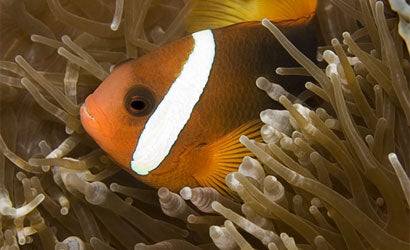5 Tips for Better Underwater Photos
You don't need a fancy diving rig to take amazing photos of colorful creatures under the sea.

As a photographer living in Guam who’s had some success shooting the beautiful creatures around nearby coral reefs, I meet many divers who ask for advice about how to get better underwater shots. Not photographers with expensive DSLR outfits in suitcase-sized underwater housings — I mean snorkelers and scuba divers who use digital compacts that are waterproof or housed in waterproof cases. Here are some tips I usually suggest:
1 Use your flash.
Underwater, sunlight is filtered by wavelength according to depth. You almost never see reds, because they’re filtered out first at just a few inches below the water’s surface. Next go the oranges, yellows, greens, and finally blues. If you don’t use flash, most of the wonderful underwater colors will record as blue — the last color to be filtered out. Using flash and getting as close as possible to the subject will result in colors that are brilliant and accurate.
2 Use your camera’s macro setting.
The macro mode on most digital cameras allows you to focus on objects very close in. The resulting pictures can reveal aspects of exotic underwater life that are too small for the unaided eye to see, and for that reason are attention-getters. Because underwater objects usually appear about 25% larger than they appear on land due to refraction, this gives your camera even more macro power. And don’t worry — some creatures, clownfish for example, don’t easily spook and will let you get close enough to use that macro mode.
3 Dive with a friend.
When diving, you should always have a buddy along for safety. As long as you’ve got one with you, why not put your diving partner to work? Get a very bright underwater light, and, when you see an interesting subject down below, have him or her use this to help you light it. BONUS TIP: If the light is daylight-balanced, it will match the color temperature of your flash, and you can use the two lights together.
4 Keep your head up.
Literally. Look up for shots, and use the sky for backlight. Continue to use your flash to get great color in backlit subjects. Also try cranking your zoom lens to its widest focal length and turning the flash off for really stunning wide-angle silhouettes of marine life or other divers that can be very sharp-edged.
5 Shoot from below.
When working around a reef, there is almost always a way to place the camera below your subject. Pictures taken looking up at a fish are striking because they include the eyes, mouth, and pectoral fins. These details make the fish seem more lifelike, and the pectoral fin can give a sense of motion. Don’t let this deter you from shooting down onto a fish, however — some wonderful pictures can be made from above. Experiment and get comfortable with upward shots first. Your reward with be a higher percentage of keepers.
Relax, Have fun, watch out for the coral, and expect to be surprised.